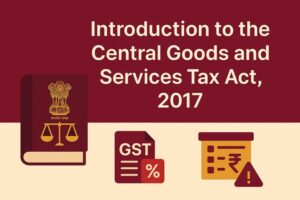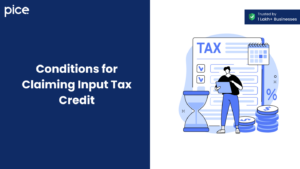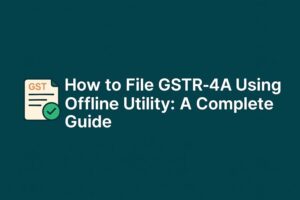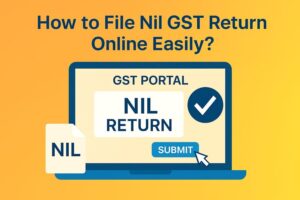Decoding GST Implications on Joint Development Agreements
- 4 Feb 25
- 11 mins
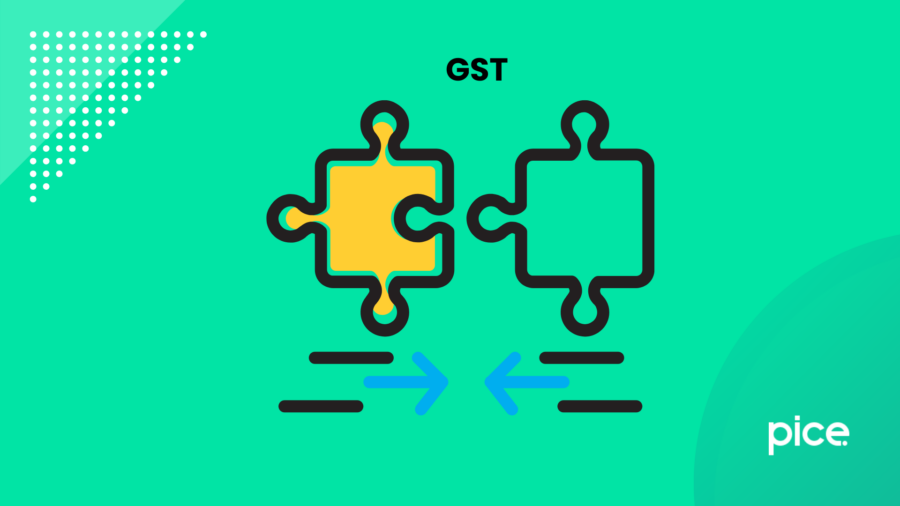
Decoding GST Implications on Joint Development Agreements
Key Takeaways
- Flat 18% GST applies to JDAs, impacting contract valuation.
- GST varies based on development rights transfer, construction, or sale.
- Residential JDAs have lower GST rates than commercial projects.
- Developers pay GST under RCM for JDAs signed after April 2019.
- ITC is available for commercial and mixed-use projects but not residential.
The authoritative council has stipulated a flat 18% GST on Joint Development Agreements, and this rate directly impacts the contract's value. JDAs are formal contracts between a real estate developer or builder and the concerned landowner to outline guidelines while building projects on the latter party’s estate.
Once the contract is mutually approved, the developer starts construction activities, and the landowner is not directly involved in their management. In this blog, you can continue learning more about a Joint Development Agreement (JDA), its scope, relevant SAC codes, and finally, the applicability of input tax credit (ITC).
What Is a Joint Development Agreement?
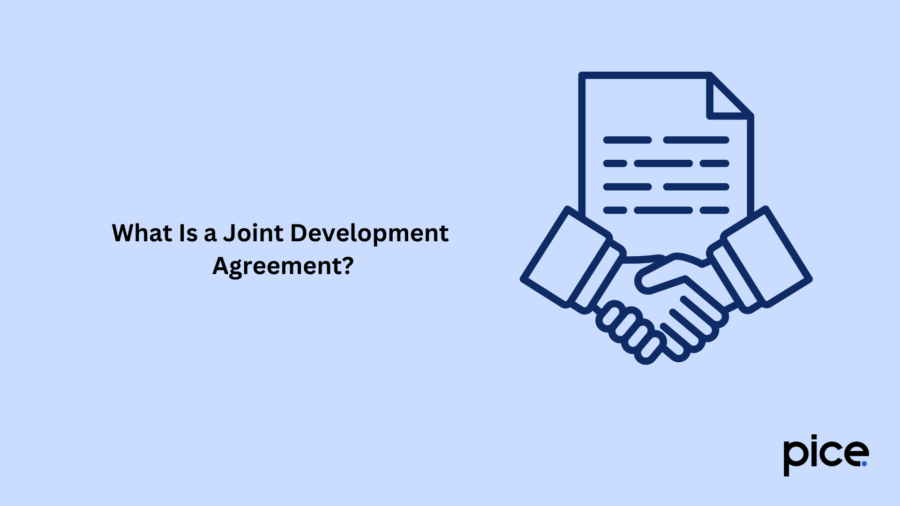
A joint development agreement, popularly referred to as a JDA, is a legal document that acts as an agreement between two or more entities who wish to develop a property together. By using this contract, a landowner can build a joint venture with the promoter, where the latter takes care of construction and development proceedings.
The JDA clearly defines the individual rights, profit-sharing nuances and responsibilities distributed among the involved parties. By understanding the common goals and through expertise, both ends are easily able to accomplish their objectives and optimise returns.
Important JDA Documents
A well-defined JDA comprises the following crucial documents:
- The Primary Document—Joint Development Agreement
This legal contract contains the base construct of a real estate project. It has several details like the landowner's responsibilities, the developer's duties, and the sharing ratio.
- Allocation Agreement
The involved parties access this resource after the joint development agreement has already been signed. It vividly demarcates the units of the project to be constructed and mentions what parts belong to the landlord and the developer.
- General Power of Attorney
A landowner and a developer enter this document to hand over to the builder certain rights on behalf of the landlord. A General Power of Attorney or GPA enables the construction business to claim required registrations, plan sanctions, apply for requisite licences and so on.
- Commencement Certificate
A local authority issues this certificate to signify that a project satisfies all the lawful prerequisites. It is a green signal for the developer to start their construction activities.
- Completion Certificate
This legal agreement substantiates that the building under question has been constructed in accordance with the approved building layout.
Furthermore, it certifies that the construction firm has adhered to all guidelines stipulated by the local administrative body. These regulations include compliance with a set building height, mandatory distance gaps from the road, and other relevant requirements. Residents or other property users will need this completion certificate while applying for basic facilities like water supply, electricity, etc.
Scope of GST on Joint Development Agreements
After the building construction is finished, the developer enters into a conveyance deed or signs an allotment letter to transfer the ownership to the landowner. To acquire the joint development agreement, a landowner needs to bear 18% GST on the quoted amount.
In every JDA, three forms of transactions can take place. According to the category, the GST applies to such transactions.
Scenario 1: When the Development Rights Are Given to the Developer by the Landowner
GST applies partly or sometimes wholly, as this act is identified as a construction service.
Scenario 2: When a Developer or Contractor Transfers Services to the Landowner
Again, in this case too, GST applies partly or fully, as the act is classified as a transfer of development rights.
Additionally, when a developed area is sold by either the landowner or developer, GST is levied on such transactions. In the segments below, let us discuss in detail the scope of GST on Joint Development Agreements.
- GST on JDA in Situations When a Landowner Transfers Development Rights
To understand the effects clearly, here we have explained the GST implications separately for both residential and commercial ventures.
- For Residential Projects
- Regulations Before March 2019: If the JDA is signed before 31st March, 2019, the owner of the plot will have to bear 18% GST. Both Section 15 of the CGST Act of 2017 and Rule 27 of the same law help define how to figure out the taxable value. Accordingly, the person liable to make the payment must finish the transaction on the constructed project’s date of transfer of ownership.
Here’s an example to make things clearer:
Suppose a landowner decides to extend the development rights of a plot valued at ₹5 lakh. Then, they will need to pay ₹90,000 (18% of ₹5 lakh) on the date of property transfer.
- Regulations After March 2019: Conversely, if both parties signed a JDA after 1st April, 2019, then the developer will be liable to furnish the GST amount. In this scenario, the reverse charge mechanism comes into play, and the Council stipulates 1% GST for affordable houses and 5% GST for non-affordable accommodation types.
Right now, the developers have to settle GST for real estate projects on a reverse charge basis according to the set margins. The tax sum is applied to the value of development rights for unsold residential apartments. This amount is determined either before the completion certificate issuance date or the first occupancy date, whichever is earlier.
In mathematical terms, the value of GST on Joint Development Agreements is:
Value = GST applicable on Developmental Rights * unbooked apartments’ total carpet area as of the issuance date of the completion certificate/total apartment area
It should be noted that under no means the payable GST can cross 0.5%-2.5% of the price of additional unbooked properties. This tax amount has to be settled before the date of construction completion or the first occupation of the apartment, whichever comes first.
For instance, suppose, a residential property is being offered at an affordable value of ₹25,000. In such a case, the landowner must pay ₹250 or 1% either when the first accommodation unit is occupied or during the issuance of the completion certificate.
- For Commercial Projects
When commercial projects are concerned, the landowner needs to furnish 18% GST while transferring development rights. Section 15 of the CGST Act and Rule 27 of the same law dictate the value on which the GST amount will be calculated.
Let’s say, a commercial building costs ₹10 lakh. In such a case, the landowner will incur ₹1,80,000 or 18% GST. This amount does not change, disregarding whether the JDA was entered before or after March 2019.
- GST on JDA in Situations When a Developer Transfers Construction Rights
The GST provisions related to construction rights vary based on the project type. Here you can find the details:
- For Residential Projects
- Regulations Before March 2019: In this case, the developer has to pay 12% GST on the transaction value. Section 15 of the Central Goods and Services Tax and CGST Rule 27 determines the value on which GST will be levied.
Additionally, the 12% GST applies only when the developer has opted for the old scheme. Conversely, those who have availed the new scheme need to pay 1.5% GST for affordable housing and 7.5% GST for non-affordable housing.
For instance, earlier the developer had to pay a 12% GST which means if a building incurred a price of ₹10 lakh then the builder had to pay an additional ₹1.2 lakh.
- Regulations on or After March 2019: After the new norms were proposed, now the developer pays a 7.5% tax for non-affordable properties and 1.5% for affordable housing on the service value set according to the price imposed on an independent buyer.
The developer has to furnish this payment on the first occupation of the concerned project or otherwise on the completion date, whichever arrives earlier.
For instance, let’s assume that the property under question is non-affordable and has a value of ₹50,00,000. In such a case, the developer must pay ₹3,75,000 as GST on the Joint Development Agreement.
- For Commercial Projects
- Regulations Before March 2019: In situations when the developer is offering construction services to a landowner, the former party has to bear a 12% GST. Here, the supply’s actual value is evaluated by Section 15 and Rule 27 of the CGST Act. The GST Council expects this payment on the date of transfer of possession. For this, the developer needs to issue a conveyance deed.
- Regulations on or After March 2019: Developers who come under this category also need to furnish 12% GST. The service’s value is determined based on the price charged from independent consumers nearest to the Joint Development Agreement.
- GST on JDA for a Normal Sale of Developed Area to the Developer by a Landowner
- Regulations Before March 2019: For these transactions, Section 15 of the CGST law indicates the transaction sum. The developer is required to submit the GST payments on the payment or invoice date, whichever comes earlier. A 12% GST is levied in these instances.
- Regulations on or After March 2019: Again, the transaction value is primarily determined by the CGST Act's Section 15. Developers pay 7.5% GST for non-affordable properties and 1.5% for affordable housing. Otherwise, a 12% GST is levied on the total transaction value. If you are a developer, you can complete the payment on the invoice date or payment date depending on the date that comes first.
GST on Joint Development Agreements (JDAs) and Important SAC Codes
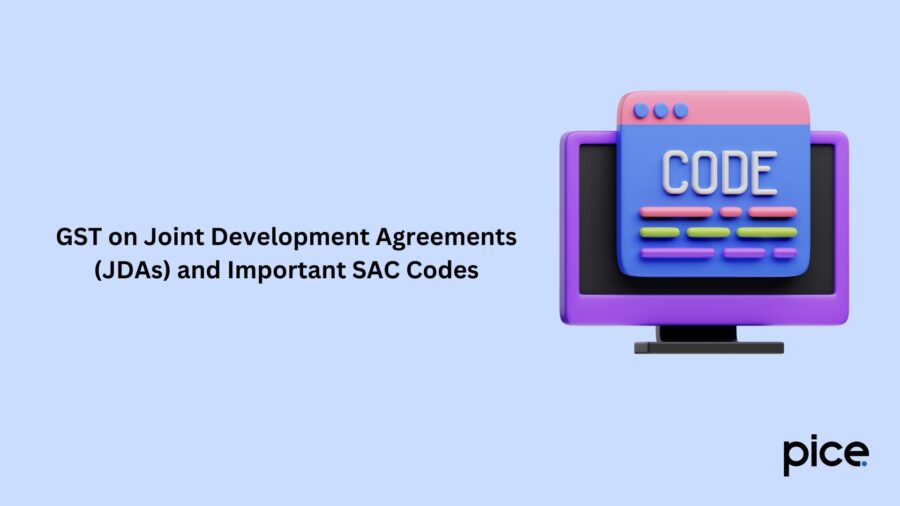
In the table below, you can find the SAC codes for various categories and see the GST applicable on corresponding JDAs:
| Category | GST Rates | SAC Codes |
| GST implications while transferring development rights (developer is responsible for paying the GST amount) | 18% | 9972 |
| GST applied to the construction facility of apartments which a developer previously handed over to the landowner as a part of the transfer of developmental rights | Affordable residential property: 1%Non-affordable residential property: 5%Commercial apartments: 12% | 9954 |
| Applicable GST on developmental rights involving residential unsold properties | 18% | 9972 |
| GST effects while transferring development rights to the developer from a landowner | Nil | 9954 |
Availability of ITC
The following table clarifies the input tax credits (ITC) for different categories:
| Transaction Category in JDA | ITC Availability (Available/ Not Available) |
| Sale of residential projects by a landowner or developer | ITC unavailable |
| Sale of commercial projects by a landowner or developer | ITC available |
| Sale of mix projects by a landowner or developer | ITC available proportionately |
| Transfer of developmental rights made to a registered builder by the concerned landowner (both for commercial and residential properties) | ITC unavailable |
Conclusion
When a Joint Development Agreement is registered, it does not signify that a landowner has handed over their ownership rights entirely to a developer. Alternatively, it is a sharing of responsibilities, and to make the most out of mutual benefits, it is imperative to learn about the implications of GST on Joint Development Rights.
You can refer to this guide for a quick reference and also take the help of experts to navigate tax compliance issues when needed.
💡If you want to streamline your payment and make GST payments, consider using the PICE App. Explore the PICE App today and take your business to new heights.
 By
By 







